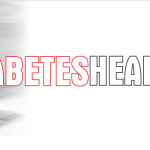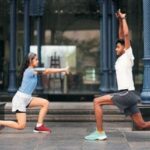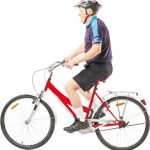Sunila Kelkar explains how indoor exercises can be just as beneficial as outdoor exercises and help you keep up your fitness routine during the monsoon season.
Exercise Matters!
One of the major causes of onset of Diabetes is stress which can be physical and psychological in nature. Exercise can definitely help reduce this stress by lowering stress hormones in the body like adrenaline, cortisol and norepinephrine.
Exercise also helps control blood sugar levels. Excess glucose in the blood occurs because either the body doesn’t use insulin appropriately or cannot produce enough insulin to process it.
Exercise can reduce the glucose in your blood. When you’re exercising muscles can use sugar without insulin. In other words, it doesn’t matter if you’re insulin resistant or if you don’t have enough insulin. When you exercise, your muscles get the sugar they need, and in turn, your blood glucose level goes down.
In the case of insulin resistance, exercise actually makes your insulin more effective. This means your insulin resistance goes down when you exercise, and your cells can use the glucose more effectively.
But even after knowing so much about the effects of exercise on Diabetes, we still struggle with shortage of time to exercise. Often times, people do not have time to go to the gym or a fitness class. The reasons could vary but it is important to continue to maintain your fitness and well- being. Indoor exercises regimes are a great way which can be done at home with minimal or no equipment.
Studies have proven that the results of exercise are same if you exercise for a long duration at a stretch or exercise multiple times in a day for a shorter duration.
Exercising multiple times for a shorter duration in a day could help full-time working individuals who cannot devote hours in the gymnasium. Those who think they have no time for bodily exercise will sooner or later have to find time for illness.
Indoor workout ideas
Start with a 10-minute warm-up followed by aerobic exercises like marching at a place or a light jog on the spot for about 15-20 minutes for 5 days a week. Self-resistance exercises can be easily done at home in the form of wall push-up, sit-ups, squats, planks, reverse planks and can be repeated about 10-12 times at least thrice a week for muscle strengthening.
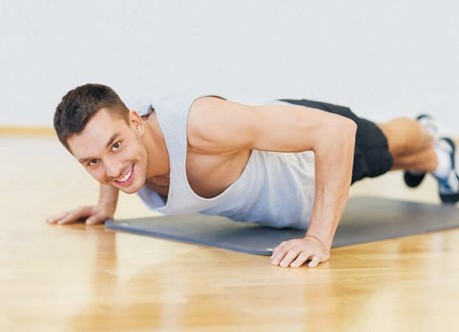
The workout session must end with
cool-down exercises for about 10 minutes.
The warm-up and cool-down phase include flexibility exercises like:
• Ankle movement (back-forth and ankle rotations clockwise and anti-clockwise)
• Calf and hamstring stretching
• Trunk side bending exercise in standing
• Arm raises and arm rotations
• Neck movements in four directions
These are tips which can be used at home or the workplace to achieve similar results as hitting the gymnasium.
While working on the computers, you can stretch your arms and legs for few seconds, knees can be straightened alternately, the spine can be elongated to the most erect position. All these exercises when done every 2 hours will take care of your flexibility.
To do something similar to cardio exercise, try using the stairs instead of elevators. You can climb 2-3 flights of stairs at your maximum speed for around 2-3 times a day. This increases your heart rate as well as the breathing rate. The more you climb better is your stamina.
For improving the strength of muscles, you can make use of the bottle of water or stack of papers. Depending on the availability, you can hold this and do the shoulder and elbow movements for 10 counts each, like moving shoulders up and down, out and in. You can also do chair push-ups wherein you have to hold the handles of the chair and lift yourself up for 10 counts. All these can be done while you are reading on the computer or going through the files.
Nowadays the new trend in office is to sit on a stability ball instead of a usual chair. This helps to activate your core abdominal muscles. These muscles are very important in preventing a bad posture or a low backache in long run.
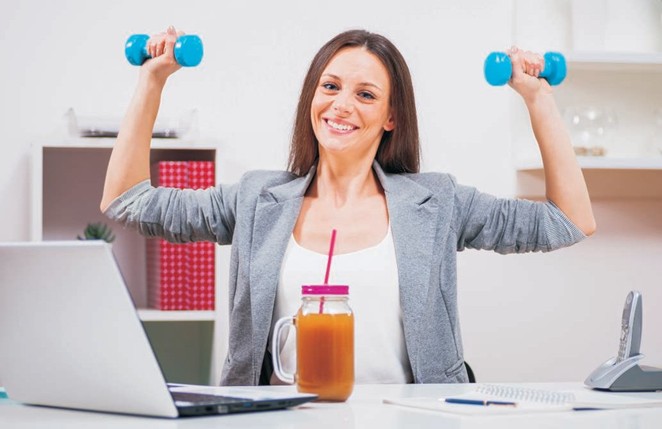
Chair exercise program
Chair exercises is a modified way of practising yoga asanas with the help of a chair as a part of yoga therapy. Chair exercises have been found beneficial for improving the quality of life in older people along with improving balance, lower limb strength, lowering depression and increasing vitality. These yoga asanas can be done by anybody irrespective of age and health conditions.
Few chair yoga asanas are explained below:
• Sit straight on a chair with both feet on the floor and place your hands on your knees or place them on the top of your thighs.
• Now gently inhale and simultaneously arch your back, gradually rolling your shoulders down and back. Now bringing your shoulder blades onto your back, you have attained the ‘cow position’.
• Slowly exhale, rounding your back or spine and drop your chin to your chest and try to touch chin to the chest. Let the shoulders and head come forward thereby attaining the ‘cat position’.
• Repeat and continue moving between cow and cat with about 5-7 inhalations and exhalations.
Spinal twist – Ardha matsyendrasana
- Sit sideways on the chair with the back straight, facing to the left side.
- Holding on to the chair, twist your torso towards the left side for a spinal twist.
- Inhale slowly and lengthen your spine on each inhale, simultaneously twist on each exhale for five to seven breaths.
- Gradually, move your legs around to the right side of the chair and repeat the twist to the right side five to seven
Raised Hands Pose – Urdhva hastasana
• Raise and stretch your arms towards the ceiling and inhale deeply.
• Maintain good upper body posture keeping your shoulders relaxed. Anchor your hips firmly to your chair seat and reach up from there, stretching upwards as much as possible.
• Repeat these five to seven times with deep inhalation.
You can customise your own exercise program consisting of a variety of exercises to challenge your cardiovascular and musculoskeletal system. 30-45 minutes session with 10-15 different exercises can be done at home. This can include squats, lunges, burpees, sumo squats, crunches, planks, side planks, leg kicks, jumping jacks, spot jogging, rope skipping, stair climbing, mountain climbers and the list can go on.
Add variety to your exercise every day and that will spice up your exercise schedule. The best part about these exercises is that they will challenge your aerobic and muscular system and all you need is a mat. You can do these at the comfort of your home in front of the TV as well.
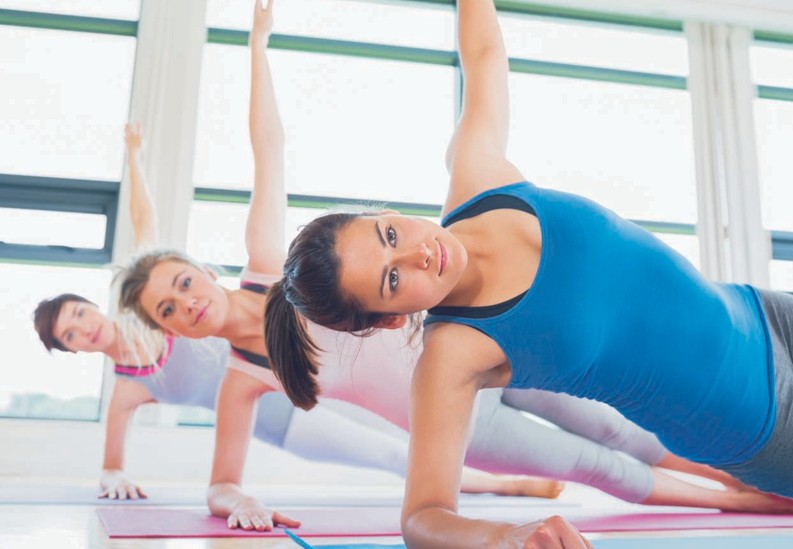
Pilates
Pilates is a form of exercise, developed by Joseph Pilates, which emphasizes the balanced development of the body through core strength, flexibility and awareness in order to support efficient, graceful movement. Pilates has a strong and fast growth of fans as it is now one of the few popular exercise techniques, adopted by many. Athletes and dancers love it, as do seniors, women rebounding from pregnancy and people who are at various stages of physical rehabilitation. Pilates is beneficial for all age groups. It is although a popular method with dancers, gymnasts, athletes and others but is suitable for all.
The best part being Pilates can be tailor made for any age.
Each class ranges from 45-60 minutes. But the thing about Pilates is you have to be extremely cautious as if your trainer asks you to a certain number of counts, you do only those. Overdoing may not feel like too much but the after effects are punishing.
Work out target areas
In Pilates, a lot of attention is paid to how our body parts are lined up in relation to each other, which is our alignment. We usually think of our alignment as our posture, but good posture is a dynamic process, dependent on the body’s ability to align its parts to respond to varying demands effectively. When the alignment is off, uneven stresses on the skeleton (especially the spine) are the result. Pilate’s exercises are done with attention to alignment, with creating uniform muscle use and development and allowing
movement to flow through the body in a natural way. It increases flexibility, body awareness, develops core strength and helps correct the posture.
Fitness level and Pilates
Pilates is for everybody. If you are a beginner, Pilates exercises will help you build up not only your core strength but also your full body strength, endurance, balance, body alignment and posture. On the other hand, there are workouts and exercises which will complement your excellent fitness levels, helping you maintain good form and alignment in any activity like sports, athletics, dance or weight training.
Pilates with apparatus or on mats
Pilates on the floor or mat is called ‘mat Pilates’. There are props used in mat Pilates to either make an exercise more challenging or easier. These props include the Pilate’s ball, bands, fitness circle, arc barrel etc.
Pilates is also done on the reformer or chair. The machines use heavy springs to create resistance and are incredibly versatile, taking the mat work to different levels. This provides support to make exercises easier or adding resistance to challenge the muscles more.
Pilates and Diabetes
It is a widely known fact that Pilates is helpful in toning muscles. Additionally, when you practice Pilates, your body is better at maintaining normal blood sugar and normal insulin levels. Pilates is great training if you’re overweight or at risk for Diabetes or have Diabetes.
Advantages of Pilate’s workout
Pilates should be practiced for some time
before we reap the benefits. There are numerous benefits; here are the main ones:
• It improves posture as it works on the torso and thighs. It is perfect for toning and strengthening muscles.
• It trains your muscles to assume the correct positions thereby preventing injury when working hard.
• It relaxes muscular tension and muscle stiffness which is relieved effectively and smoothly.
• It helps relax your mind as it helps reduce stress, particularly through the importance of breathing.
• It improves physical fitness by increasing strength and flexibility.
• It relieves joint problems. This gentle technique is a good way to relieve back pain, sciatica and other joint pain.
• It provides rehabilitation. After recovering from an illness, it is the perfect technique to get you back on your feet.
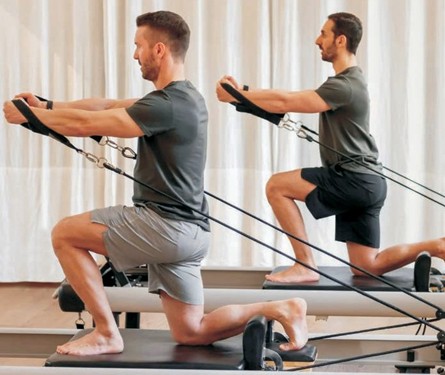
Yoga
India is the origin of yoga and it is one of the oldest forms of exercise science. It dates back to centuries. Yoga is a physical and mental exercise which involves different asanas targeting different muscles and
body parts and also the body as a whole. It emphasizes on stretching, core strengthening and variety of breathing exercises. It helps you connect your mind and soul and together nurtures your body towards a healthy being. 45-60 mins of yoga session can rejuvenate you like nothing else.
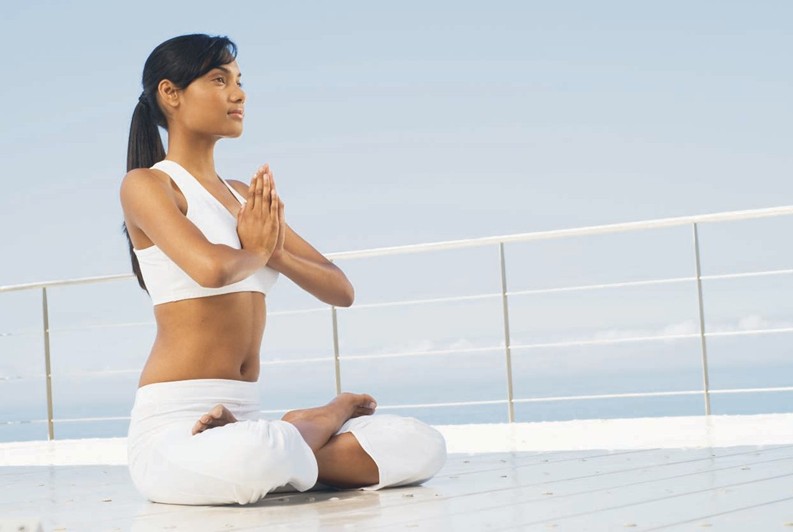
Sukhasana (cross-legged or happy pose)
Formation of the posture
• Lie down on your back.
• Stretch your legs forward and bring your hands on the sides of your body with palms on the floor.
• Lift your upper body to attain sitting posture with legs stretched out.
• Fold the left leg and tuck it inside the right thigh.
• Fold the right leg and tuck inside the left thigh.
• Bring your palms together to hold pranam in front of your Heart Chakra.
• Sit right by keeping the spine straight.
• Keep breathing in a normal manner.
• Place your palms on the floor beside your pelvis and straighten your legs forward.
• Relax by sitting with your legs straight.
Word of advice
Sukhasana helps in stretching and increasing the length of the spine. It broadens the collarbones and the chest. This asana helps achieve peace of mind and reduces anxiety, stress and mental tiredness. It helps in improving body posture. It is recommended not to perform this pose in case of any severe leg problem or knee problem. One should also not practice this pose if they have any pain in the lower spine or sciatica.
Vajrasana (thunderbolt pose)
Formation of the posture
• Sit on the floor with your knees close together.
• Place your right big toe on your left big toe, keeping your heels apart.
• Rest your pelvis on your heels and hands on your knees with palms facing down.
• Keep your spine, head and neck in a linear position should be upright and straight without straining. Do not arch your back.
• Observe the total posture of your body and make necessary adjustments so
Word of advice
Vajrasna helps in improving digestion. This is the only asana which can be done at any time of the day – even just before food and just after food. The calf muscles are also sometimes known as the second heart of the body because our mobility is determined by the strength of the calf muscles. Vajrasana mobilises and relaxes the calf muscles. This posture relaxes and strengthens the feet, ankle and the knees. It brings flexibility to the ankle and relaxes abdominal muscles. Vajrasana is a good posture for meditation and/or pranayama. A person suffering from joint pain, arthritis or any knee injury should avoid this asana.
Baddhakonsana variation (butterfly pose (chest-to-feet variation)
Formation of the posture
• Sit in a comfortable position by keeping your back and head straight.
• Fold legs in front of you and bring the
sole of your feet together.
• Bring your heels as close to your groin as possible.
• Push your knees down towards the floor while bringing your calf close to your thighs.
• Interlock your fingers and place them under your feet.
• Stretch your spine upward. Open your chest and tuck your abdomen in.
• Inhale to lift up and exhale as you bring feet close towards your chest.
• You can use your elbows to lock your
arms around your legs.
• Keep your torso straight and focus your gaze on the horizon.
• Balance and hold for a long duration.
• Exhale and relax muscles, stretch out legs to release pressure from thighs.
• Repeat the posture for 3-4 times.
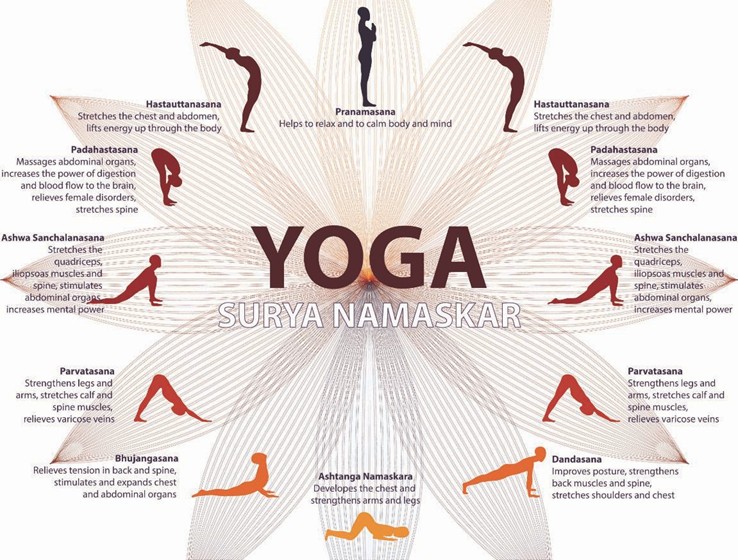
Word of advice
Baddhakonsana helps keep the kidney and prostate glands healthy. It reduces sciatic pain and prevents hernia. This posture also helps relax the heart and improves the functioning of the nervous system.
Baddhakonsana makes the spinal cord flexible and strong.
Marjari Asana (cat pose)
Formation of the posture
• Stand on your knees with your palms rested on the floor.
• Your knees should be positioned under your pelvis in alignment with your palms.
• Keep your toes out and head in line with spine.
• Inhale to curl your back and look up.
• Exhale to arch your back and look down at your navel.
• Repeat this asana for 3-4 times.
Word of advice
This asana improves the flexibility of the neck, spine and the shoulders.
Note: Proceed slowly while doing yogasana. Stop doing the yoga postures if you feel any pain or discomfort and resume only after you feel better.
Cycling
Cycling is a great way to keep fit. It really works wonders and you don’t require any special training to enjoy this simple activity. If you have an indoor cycle at home that will be perfect. But if not then do not worry. Cycling means lying down on the mat and air cycling with your legs raised by alternately bringing your knees up in circles. Make sure you don’t arch from your back and continue doing so for 15-20 repetitions and 2-3 sets. This exercise mimics your cycling and is a high core and aerobic workout. Apart from this, there are many core exercises which can be performed at home on the mat. So, you can add some crunches, scissors, dead bugs etc. while you are lying down on the mat.

Cycling benefits all
Cycling is a great workout for all parts of your body as you balance yourself while pedalling the bike. It is comfortable and enjoyable form for losing weight and is relatively a non-weight bearing exercise
unless you’re cycling in a standing position. In addition, it also:
- Improves cardiovascular fitness – Cycling makes the heart beat in a steady manner and improves cardiovascular fitness. Since it utilises the largest muscle groups, i.e. legs, it increases the heart rate and improves overall stamina and fitness. According to the British Medical Association, cycling just 20 miles a week can reduce the risk of heart disease by 50 per cent.
- Boosts stamina – cycling regularly enhances your endurance levels.
- Builds strength and muscle tone – cycling improves your muscle strength and tone. Since cycling involves working the entire body, not only the legs, it builds the entire body strength in a holistic manner.
- Aids weight loss and management – cycling helps to shed fat and keep the weight off. Regular bike riding keeps the body lean and toned (less opportunity for flabby arms and legs). Althoughmost people feel that the abdominal muscles are not being exercised the truth is that cycling also tightens the abdominal muscles and makes you look better defined.
- Great workout in certain medical conditions – Cycling can be done even if you have arthritis of the lower limbs, lower back pains and history of knee or ankle injuries. Since pedal power is low impact, it takes the weight of the body. Therefore, most people who cannot do high impact sports or activities because of the pressure it puts on their
joints, such as running, cycling serves a great alternative.
- Reduces stress – Cycling reduces stress and depression and improves overall well-being and self-esteem. It is great for the mind and soul. Cycling outdoors is also a good way to be one with nature and to rejuvenate as it de- stresses the mind and releases happy hormones, endorphins.
Rehabilitation – Being a non- weight bearing exercise it does not put pressure on the joints. Stationary cycle (may or may not be accompanied with a back rest) and recumbent cycle (bicycles with back rest) are commonly recommended for people with leg injury, diabetic neuropathy, lower back aches and pains, central obesity etc. Owing to the low impact it has on the joints it is commonly used in foot and knee rehabilitation programs
Safety tips
Remember to stay hydrated as cycling causes sweating. Keep sipping a little water to replace the lost fluid and electrolytes.
Shift position frequently while cycling and change your hand and body position so that different muscles are worked and pressure is put on different nerves. Also avoid keeping your hands on the curved part of the handle bar for a long time as this causes cramps in hands, shoulders and neck. Try and keep the arms relaxed; and avoid elbow locking, as this will act as a shock absorber.
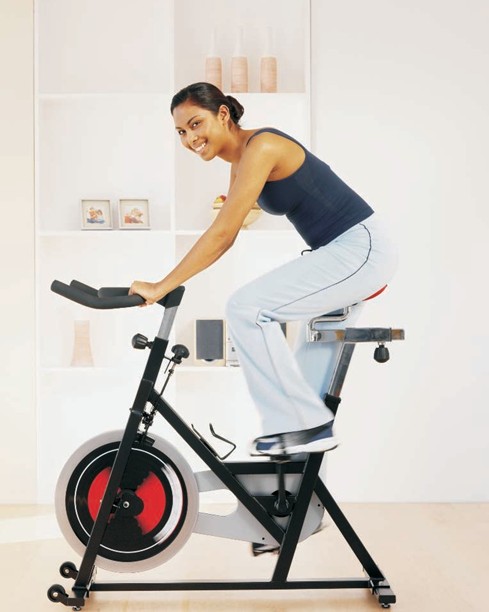
Dance
Dance is an excellent form of exercise. When you are dancing alone at home with no one to watch you, you can let go of yourself to the fullest and thoroughly enjoy this exercise form. Dancing helps in full body muscles toning, improves aerobic fitness, helps to reduce weight, and this is something your heart will love doing. If you cannot go to a dance class yourself, then you can watch the videos on TV or laptop and follow the instructor. An excellent energetic dance session of 30-45 minutes is sure to burn that fat, give you good heart pumping. Since no one else is watching you, for all those awkward, shy party dancers, this will help you come out of the closet and let yourself loose to the beats!!
Keeping fit is very important if you have Diabetes. Dance often requires stamina, fitness and flexibility. Leisure dancing is gentler but, nevertheless, like with any other type of physical activity, it can help to improve your Diabetes control and help you to manage your weight. Not just that, the benefits you accrue often develop without you even realising. Combined with great music and a friendly, social atmosphere, you’ll find that you feel better both mentally and physically and quite quickly.
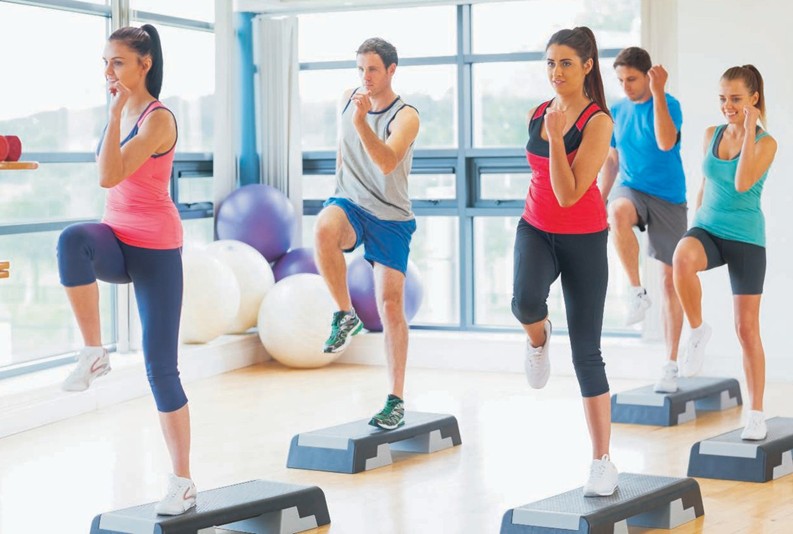
Controlling Diabetes while dancing:
- Inform your doctor that you are learning to dance.
- If you are susceptible to hypos, always take fast-acting carbohydrate food, such as glucose tablets or juice, with you to the lesson.
- Depending on the length of the session, you may have to plan your carbohydrate intake more carefully than usual. This is particularly important where dancing competitions are concerned as they can last all day
- Dancing can be a very high-impact activity, so it is advisable to wear proper, good-fitting dancing shoes. Wearing outdoor shoes is not good in the long run.
- Wear cotton socks and inspect your feet regularly for any potential pressure point problems, friction burns, signs of calluses, changes in colour and breaks in the skin.
- Don’t dance if you are feeling
To conclude
Always consult your doctor, physiotherapist and dietician before starting or modifying your exercise routine as exercise routines need to be tailor made based on your health parameters. It is important to remember that, for all the above-mentioned forms of exercises, a warm-up of 10-15 minutes and cool down of 5-10 minutes is a must to get our bodies ready for the upcoming exercise and to avoid any injury to muscles and to avoid any unnecessary stress on your heart. Key to healthy living is scientifically structured regular exercise routine, whether it is at home or outside. So do not let the inability to go out for exercising come in the way of your path to fitness. It is time to stop worrying about weight gain and enjoy that well-earned food platter after a good energetic exercise session at home!

